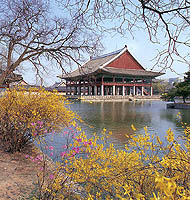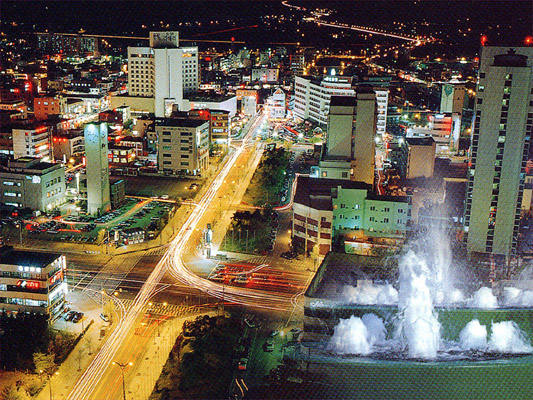Seoulmore information
GyeongbokgungMany of the buildings at the palace were demolished during the Japanese colonial
period. However, in the 1990s, the government launched restoration of the palace,
and it has now been restored to its original state. On the site stand Geunjeongjeon,
Gyeonghoeru, Hyangwonjeong, and Amisan Chimney, all in their original states.
Namsan Park
The Namsan Park is located at the center of Seoul and the location covers
both Junggu and Yongsangu. The park was decided to be built according to the
City Facility Plan on March 1940. The total area is 2,956,928m2 and the height
is 265m.
InsadongInsa-dong is the ideal place for visitors who want to experience the true
character of Korean art, with its subtle, enduring beauty. Once you are in Insa-dong,
you will immediately be drawn to the small alleys lined with numerous shops
and galleries, both tiny and spacious: antique shops, Korean stationery stores,
frame shops, handicraft shops, pottery and porcelain shops, bookstores and painting
studios, and art supply stores. In addition, restaurants and cafes serve traditional
food and teas.
Namdaemun MarketAs Korea's largest and oldest traditional market, Namdaemun is a barometer of Seoul's economic situation and where Seoulites can comparison shop for the lowest prices on all sorts of goods. It is also a world-famous shopping paradise and an attraction that tourists should not miss. At Namdaemun, a great deal of effort has been made to foster a tourist-friendly atmosphere. Information is available for local residents and tourists and free interpretation services (both in English and in Japanese) are readily offered to foreign tourists.
Lotte WorldLotte World, an all-weather recreational complex offering sightseeing, adventure, mystery, sports activities and cultural events in one place, is comprised of numerous indoor and outdoor facilities. Lotte Adventure, an indoor theme park area measuring 25,000 pyeong (82,650 square meters), keeps visitors dry even on rainy days with a glass dome that covers the entire space. Magic Island, Korea's first park built around a lake, is linked to Lotte Adventure via monorail system and overpass. Recently, the most popular ride on Magic Island is Gyro Drop, where brave souls experience the thrill of a Bunjee jumping, and at the same time enjoy the beautiful scenery of Seokchon Lake. The Trevii Fountain in the Jamsil Station Plaza on Subway No. 2 Line, which is directly linked to the Lotte World entrance, is a popular gathering spot for all, whether young or old, and for families visiting the theme park.
Hangang Pleasure BoatsIn 1986 ferry cruises were started along the sinuous waterway of Hangang
River, which flows through the heart of Seoul from the east to the west. Currently
there are four ferry terminals, six cruise boats, and 10 motorboats, all offering
leisurely excursions. The ferry terminals are located by the riverside at Yeouido,
Jamsil, Ttukseom, and Yangwha. Each terminal has a lounge below the deck. The
sightseeing boats can be reserved for special occasions including parties, ceremonies,
recitals, meeting and seminars.
Daejeonmore information
Sikjangsan (Mt.)Mt. Sikjang is a beautiful ecological treasure house. Looking east from sikjang, one can see downtown Daejeon, Mt. Sikjang is 623.6 meters high and is located near Panam-dong in Dong-gu, Secheon-dong, and Sannae-dong. As the highest mountain in Daejeon, it has a graceful physical appearance, as well as eeotic. It is plants, and historic relics. It is associated with many legends.
Yuseong SpaAt the decline of the Baekje Era, a mother who sought drugs for her son who had been seriously wounded in a battle during the Silla dynasty, saw a crane with a wounded wing on a snow-capped field. It immersed it self in a water puddle and was cured. She then let her son put his limb in the water and it was cured completely. After that, she built a hut near the fountain and invited many ill or injured people to bathe and treat their diseases there.
Expo ParkThe Expo Park, with its focus on science and the future, enhances the consciousness
of the importance of science in many young people's minds and upholds the spirit
of '93 Expo.
Daecheonghosu (Lake)As a source of water supply to the Daejeon and Cheongju area, the Lake Daecheongho
is also a tourist attraction well supplied with mountains and trees. |









